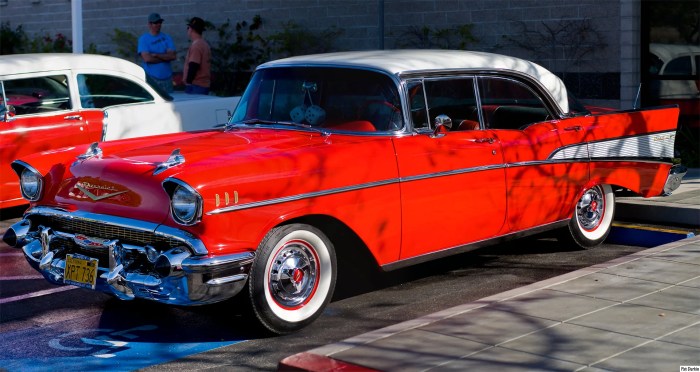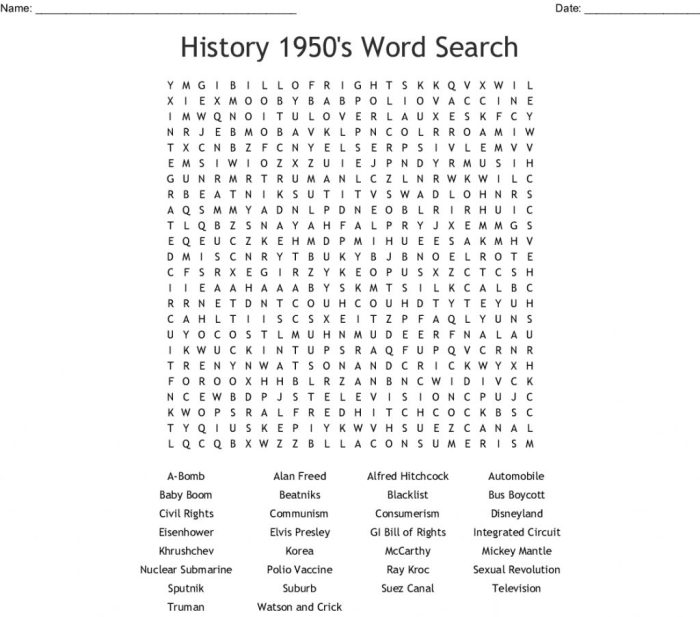Dive into the groovy world of cool in the 50s crossword and discover the hip lingo that defined a generation. From the iconic James Dean to the swinging sounds of rock ‘n’ roll, this linguistic journey will transport you back to an era where “cool” was king.
Prepare to unravel the etymological roots of “cool” and trace its evolution through the decades, uncovering the slang terms and phrases that made the 1950s so distinct. Get ready to explore the social norms and expectations that shaped “cool” behavior, and delve into the artistic expressions that captured its essence.
Cultural Significance
The 1950s marked a pivotal era in American history, characterized by significant social, economic, and cultural shifts. The end of World War II and the ensuing economic boom led to a period of prosperity and optimism, which had a profound impact on the nation’s youth.
Against this backdrop, the concept of “cool” emerged as a defining characteristic of the 1950s. It represented a rebellion against the conformity and traditional values of the previous generation and embodied a spirit of individuality, freedom, and self-expression.
Pop Culture Icons
The rise of pop culture icons, such as James Dean and Marlon Brando, played a significant role in shaping the perception of coolness during this era. Their rebellious attitudes, unconventional style, and charismatic personalities resonated with young people who sought to break free from societal norms.
- James Dean’s portrayal of troubled and sensitive characters in films like “Rebel Without a Cause” and “East of Eden” made him an icon of youthful angst and alienation.
- Marlon Brando’s portrayal of brooding and introspective characters in films like “The Wild One” and “On the Waterfront” exemplified the cool, detached persona that became synonymous with the era.
Linguistic Evolution

The term “cool” has undergone a significant linguistic journey, evolving from its initial meaning to the multifaceted concept we recognize today. Its etymological roots can be traced back to the Old English word “col,” meaning “cold.” Over time, the term gradually expanded in its semantic range, encompassing not only physical sensations but also abstract qualities.
In the context of the 1950s, “cool” emerged as a central concept within youth culture, embodying a distinct set of values and attitudes. It denoted a relaxed, confident, and stylish demeanor, often associated with rebellion against societal norms. This usage of “cool” reflected a broader shift in cultural values, as the post-war generation sought to break free from the conformity and conservatism of the past.
Slang Terms and Phrases
During the 1950s, “cool” became a ubiquitous term in youth slang, spawning a range of associated expressions. These phrases captured the essence of the “cool” lifestyle, reflecting its emphasis on relaxation, individuality, and rebellion.
- “Cool cat”:A stylish and sophisticated person.
- “Cool daddy-o”:A hip and confident individual.
- “Cool it”:To relax or calm down.
- “Cool as a cucumber”:Extremely calm and collected.
li> “Cool breeze”:A relaxed and carefree person.
Social Norms and Expectations: Cool In The 50s Crossword

In the 1950s, “cool” behavior was highly valued and sought after, particularly among teenagers and young adults. It was characterized by a combination of attitudes, behaviors, and styles that reflected a sense of confidence, independence, and nonconformity.
Coolness was often associated with rebellion against traditional social norms and expectations. Teenagers who embraced the cool lifestyle often rejected the values and behaviors of their parents and other adults, seeking to establish their own unique identities and express their individuality.
Gendered Aspects of Coolness
Coolness was perceived differently for men and women in the 1950s. For men, it was often associated with masculinity, athleticism, and a rebellious attitude. Cool guys were typically seen as confident, independent, and unafraid to take risks. They often engaged in activities such as playing sports, riding motorcycles, and listening to rock ‘n’ roll music.
For women, coolness was often associated with femininity, beauty, and popularity. Cool girls were typically seen as attractive, stylish, and outgoing. They often participated in activities such as cheerleading, dancing, and going to sock hops.
Peer Pressure and Social Conformity
Peer pressure and social conformity played a significant role in the pursuit of cool status in the 1950s. Teenagers who wanted to be cool often felt the need to conform to the expectations of their peers. They might adopt certain styles of dress, speech, and behavior in order to fit in with the cool crowd.
However, there were also some teenagers who resisted the pressure to conform and instead embraced their own unique sense of style and individuality. These teenagers were often seen as being even cooler than those who simply followed the crowd.
Artistic Expressions

The “cool” aesthetic of the 1950s permeated various art forms, shaping the cultural landscape and defining a generation’s sensibilities.
The ‘cool in the 50s’ crossword puzzle can be a real brain teaser. If you’re struggling to find the answers, check out the nihss group a answer key . It provides a comprehensive list of solutions to help you complete the puzzle.
Once you’ve solved the crossword, you’ll be feeling as cool as a cat in the 50s.
In music, the emergence of rock and roll and rhythm and blues provided a soundtrack to the era’s rebellious and youthful spirit. Artists like Elvis Presley, Chuck Berry, and Buddy Holly embodied the cool persona with their energetic performances and iconic styles.
Film
Hollywood films of the 1950s often featured “cool” characters who defied social norms and embraced nonconformity. Actors like James Dean, Marlon Brando, and Audrey Hepburn became icons of the era, representing the rebellious and stylish aspects of “cool.”
Literature
The Beat Generation writers, such as Jack Kerouac and Allen Ginsberg, explored themes of nonconformity, spontaneity, and the search for authentic experiences in their works. Their writings captured the restless and adventurous spirit of the “cool” generation.
Legacy and Impact
The concept of “cool” that emerged in the 1950s has had a lasting impact on subsequent generations, shaping cultural norms and influencing artistic expressions. The definition and expression of coolness have evolved over time, reflecting changing societal values and technological advancements.
In the decades following the 1950s, the concept of “cool” became synonymous with rebellion and nonconformity. The youth of the 1960s and 1970s embraced a counterculture that rejected the conservatism of the previous era. Coolness was associated with individualism, authenticity, and a rejection of mainstream values.
Enduring Influence in Contemporary Culture, Cool in the 50s crossword
Today, the concept of “cool” continues to hold significant influence in contemporary culture. It is often associated with style, confidence, and effortless charisma. Coolness is expressed through fashion, music, art, and social media. Brands and celebrities alike strive to project an image of coolness to appeal to consumers and followers.
The internet and social media have played a significant role in shaping the contemporary definition of coolness. Social media platforms allow individuals to curate their online presence, presenting a carefully crafted image that conforms to the latest trends. Coolness has become increasingly intertwined with digital savvy and online reputation.
Essential FAQs
What does “cool” mean in the context of the 1950s?
In the 1950s, “cool” referred to a certain attitude and style that emphasized independence, confidence, and nonconformity.
Who were some of the icons of “cool” in the 1950s?
James Dean, Marlon Brando, and Elvis Presley were among the most iconic figures who embodied the “cool” aesthetic and attitude of the era.
How did music influence the concept of “cool” in the 1950s?
Rock ‘n’ roll music, with its rebellious and energetic sound, played a significant role in shaping the definition of “cool” during this period.